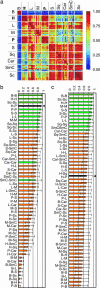Evidence by molecular profiling for a placental origin of infantile hemangioma
- PMID: 16365311
- PMCID: PMC1323205
- DOI: 10.1073/pnas.0509579102
Evidence by molecular profiling for a placental origin of infantile hemangioma
Abstract
The origin of the pathogenic endothelial cells in common infantile hemangioma is unknown. We show here that the transcriptomes of human placenta and infantile hemangioma are sufficiently similar to suggest a placental origin for this tumor, expanding on recent immunophenotypical studies that have suggested this possibility [North, P. E., et al. (2001) Arch. Dermatol. 137, 559-570]. The transcriptomes of placenta, hemangioma, and eight normal and diseased tissues were compared by hierarchical and nonhierarchical clustering analysis of >7,800 genes. We found that the level of transcriptome similarity between placenta and hemangioma exceeded that of any other tissue compared and paralleled that observed between a given tissue and its derived tumor, such as normal and cancerous lung. The degree of similarity was even greater when a subset of endothelial cell-specific genes was analyzed. Genes preferentially expressed in both placenta and hemangiomas were identified, including 17-beta hydroxysteroid dehydrogenase type 2 and tissue factor pathway inhibitor 2. These data demonstrate the value of global molecular profiling of tissues as a tool for hypothesis-driven research. Furthermore, it suggests that the unique self-limited growth of infantile hemangioma may, in fact, mirror the lifetime of placental endothelium.
Figures



References
-
- Fishman, S. J. & Mulliken, J. B. (1993) Pediatr. Clin. North Am. 40, 1177-1200. - PubMed
-
- Mulliken, J. B., Fishman, S. J. & Burrows, P. E. (2000) Curr. Probl. Surg. 37, 517-584. - PubMed
-
- Gonzalez-Crussi, F. & Reyes-Mugica, M. (1991) Am. J. Surg. Pathol. 15, 769-778. - PubMed
-
- Nguyen, V. A., Furhapter, C., Romani, N., Weber, F. & Sepp, N. (2004) Hum. Pathol. 35, 739-744. - PubMed
Publication types
MeSH terms
Substances
Grants and funding
LinkOut - more resources
Full Text Sources
Other Literature Sources
Medical

